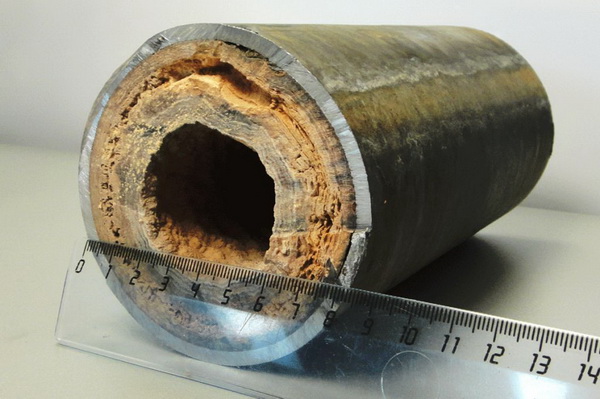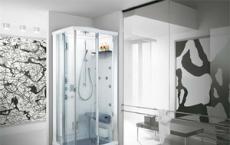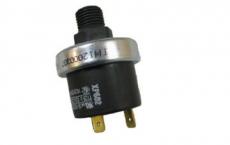How to flush closed heating system. Washing of the heating system at home and hot water.
Each developer, investing in the creation of an autonomous water heating system, hopes for its reliability and efficiency. Competent calculation, use of the best materials and equipment really make it possible to be sure of its smooth operation for many years. But it happens that after a few years, the owner notices that with each heating season, fuel consumption increases for heating of the coolant, which affects the growth of operating and utility costs.
Availability central heating does not solve the problem: from year to year in most residential buildings, the batteries heat up worse, the adjustment of the heating system apartment building nothing gives. That is why many real estate owners are conducting procedures for the insulation of external walls, in order to preserve the precious heat in their homes. About why the efficiency of heating systems decreases over time and how to deal with this problem will be discussed in this publication.
Why do not the batteries heat well?
If you are asking this question, then it's time to remember when you last washed your heating system. Of course, the owners of autonomous heating most often sin on the settings of the boiler equipment and overgrown heat exchanger boiler. And few people think that the blame for all the clogged pipes and radiators on the walls of which accumulated lime deposits from the circulation of hot coolant of increased rigidity. It is these clogs that reduce the velocity of the coolant, the amount of water flow and heat transfer.
Experts calculated that the coating on the inner wall of all radiators, only 1 mm thick, reduces the efficiency of heating by 15-20%, and increases fuel consumption by 10-13%.
Important! It should not be forgotten that the reduction in the cross-section of pipes in heating systems with forced circulation, increases the pressure in the circuit, which can lead to rupture of the pipeline and leakage of radiators. And this is damage to property and possible costs for repairing the premises on the floor below.
Timely maintenance of heating systems - that's what will not let you freeze in the winter cold. If the radiators have become noticeably colder with the same settings of the boiler equipment and air temperature, then without delay, rinse the system.
To date, there are three main ways of cleaning CO: chemical, hydrodynamic and hydropneumatic. Each of them has advantages and disadvantages, and also requires a competent approach, knowledge and special equipment. The choice of this or that washing method occurs only after the system is diagnosed.
Important! Rules and permissible technologies are regulated health standards 3.05.03-85 and 3.05.01-85.
Chemical Cleaning
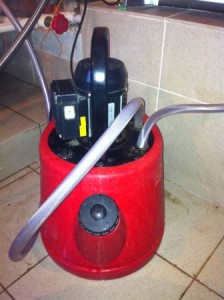 The essence of the method is to introduce into the heating system special reagents that exfoliate and dissolve the calcareous deposits, cobbled dirt and debris. These chemicals predominantly consist of acids, alkalis and various solvents. Typically, this washing method is used for stand-alone COs, so if you have a question about how to flush the heating system in a private house, chemical cleaning is a good option.
The essence of the method is to introduce into the heating system special reagents that exfoliate and dissolve the calcareous deposits, cobbled dirt and debris. These chemicals predominantly consist of acids, alkalis and various solvents. Typically, this washing method is used for stand-alone COs, so if you have a question about how to flush the heating system in a private house, chemical cleaning is a good option.
The washing process is as follows: a reagent is injected into the CO using a pump, which is selected depending on the material of the pipeline, the batteries and the degree of their contamination. This method has several advantages:
- This method does not require the descent of the coolant from the system, therefore the washing can be performed at any time of the year.
- The result is achieved after a lapse of 1 to 3 days without human intervention.
Do not forget about the shortcomings:
- Not all contaminants dissolve. Some of them settle in the bottom of the radiator sections, which reduces their throughput.
- This method is not suitable for high wear rates.
- Chemical cleaning does not apply to systems that use aluminum radiators and aluminum alloy equipment.
- The contents of the CO can not be discharged into the sewer system.
In addition, the reagents are quite toxic, so the chemical flushing of heating systems in a private house requires special care and good ventilation.
Hydropneumatic method
This method is based on applying air to CO under high pressure. Mixed with water, air bubbles under the influence of turbulent flows effectively peel off and break down perennial calcareous and organic deposits.
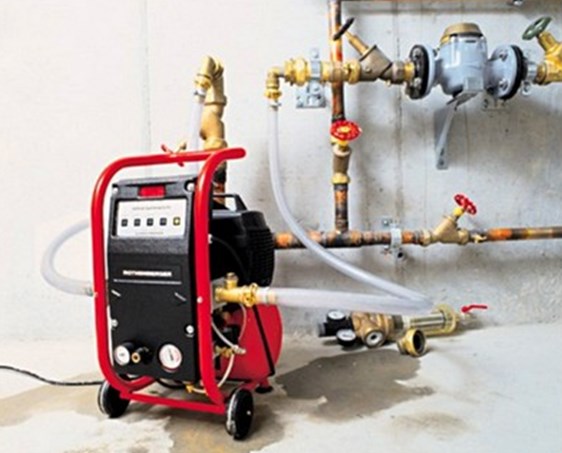 So, how to pump the heating system in a private house? This requires an air compressor and a thorough knowledge of the washing technology.
So, how to pump the heating system in a private house? This requires an air compressor and a thorough knowledge of the washing technology.
- Close the return.
- Connect the compressor to the back branch.
- Open the discharge valve on the return line.
- Start the compressor. After reaching a pressure of 6 atmospheres in the receiver, apply an air flow to the CO.
The procedure is carried out before the pipeline is completely cleaned, the indicator of which serves pure water on reset. Similar procedures should be carried out on the filing branch.
Advantages of this method in the simplicity of the procedure, its cheapness and efficiency. Disadvantage can be considered the inability to use in worn out CO.
Hydrodynamic flushing
This method can be safely called the simplest, sparing, but not the most effective. The essence of this method of purification is the flow of flowing water into the SO under pressure. Water effectively dissolves organic sediments, getting into the pores of the calcareous layers, deliquesces and breaks them into small components, which, together with the flow, are discharged to the sewerage system. Because of the ease of use, this method of washing the heating system in apartment house, is most often used.
Pluses: simplicity and comparative cheapness.
Disadvantages: low efficiency when removing solid precipitation.
There is another innovative method of cleaning heating systems - dispersed. As in the case of chemical washing, a reagent is introduced into the CO, which, unlike chemistry, does not react with impurities and deposits, but destroys their structure. After the process of pollution, they are discharged from the system by the flow of water into the sewerage system.
According to the creators of the disperse method, their reagent does not react with metal (pipes, batteries), creates a hydrophobic film on the inner surface of the pipeline and batteries, reduces the hydraulic resistance of CO.
How to Rinse Batteries
Typically, to easily dissolve deposits in aluminum radiators and cast-iron batteries, you can apply a method of gentle chemical cleaning. It is recommended to use the following tools:
- Fill the radiators with serum. Lactic acid will soften the contamination. After that, the batteries should be washed with running water.
- Fill the radiator with soda and fill the radiator with boiling water. After cooling, drain and rinse.
- Use a radiator washer fluid. Fill the battery, drain after 5 hours. Repeat the procedure if necessary.
Tip: The easiest way for self-cleaning radiators is hydrodynamic. Remove the radiator, connect the hoses to the inlet and outlet. The inlet hose is connected to the water supply and the outlet is lowered into the sewer. The water pressure will remove most of the organic deposits, which will significantly improve the heat transfer efficiency of the radiator.

For the heating system to remain effective and efficient for the longest period of time, it must be periodically rinsed. This simple measure in its carrying out allows to eliminate scum and various garbage from the system elements.
According to the rules, the washing of the heating system should be done by specially trained people. But if you want, you can do it yourself. Study the guide and proceed.
Have you noticed that one of your friends or neighbors has a much warmer battery than your home? There may be several reasons for this, but the most common is the presence of clogging in the heating mains. It is to eliminate such troubles and prevent their further appearance and flushing is performed.
The efficiency of heating is reduced due to two main factors, namely:

To the greatest extent silting is affected by cast-iron batteries, as well as radiators with a large number of sections. The dependence is simple: the more sections and the more bulky, the slower the coolant moves through the system and the higher the probability of silting.
Instructions for flushing the heating system
There are 2 basic washing methods heating system, namely:
- with the use of special hydropneumatic equipment;
- using chemical reagents.
Hydropneumatic washing
Hydropneumatic flushing of heating systems - instruction
This method is actively used by domestic ZhEKs and is quite effective. You just need to do everything in accordance with the technology.
The principle is extremely simple: first the water is discharged from the system, then it is fed back. A special pneumatic pump is used to "adjust" the water flow. As a result, under the influence of a rather powerful head, scaling of the scale and other deposits occurs, and when draining the water, they are removed from the system.
To perform this procedure on your own, you will need a pneumatic pump that can pump more than 6 kg / cm 2.
The sequence of actions is as follows.
First step. We close the gate valve "return".
The second step. We connect the pneumatic pump to the valve installed after the valve.
The third step. We drop the "return".
The fourth step. We give the pneumatic pump to apply pressure above 6 kg / cm 2, and then open the valve to which it is connected.
Fifth step. Alternately overlap all the risers. We do this so that at a time no more than 10 risers are blocked. Compliance with this rule will make the washing procedure as efficient as possible.
The sixth step. We translate the system to a drop in the opposite direction. For this we do the following:
- close the reset and close the valve connected to the pump, and turn off the device;
- close the open latch, and then open the similar on the "return";
- reset the heating system. To do this, we connect the pneumatic pump to the valve in the reverse direction, then open the valve and turn on the pump. The fluid will move in a different direction.
Determine the required duration of washing can be "by sight". A clean, clear liquid started to come out of the system? You can finish! Return the valves and valves to their original position and turn off the pump.
To collect dirty water, prepare a suitable container. If you want, you can connect the hose to the battery and ensure that the dirty coolant is diverted to the sewerage system.
Chemical washing
The use of this method can only be resorted to in two cases, namely:
- if necessary, clean the heating system with natural circulation, built using steel pipes. It is advisable to use chemical reagents in situations where, for any reason, there is no desire to wash the entire system. Most often, blockages are deposited in heat exchangers. The system can be silenced on the entire perimeter. In the second case, there will not be a special kind of chemical washing;
- if necessary, restore the old heating system. Over the decades of operation, the pipes can become clogged and overgrown so that the capacity of the pneumatic pump will not be sufficient for effective cleaning. It is possible, of course, to take a more powerful pump, but no one will guarantee that the pipes will not burst under such pressure.
Important! If the pipes are very old, with traces of corrosion and deformation damages, there can be no positive result from washing. Chemical reagents will simply dissolve the rust, as a result of which the pipes will begin to leak. The only effective solution in this situation will be the replacement of the served roads.
The principle of washing is simple: instead of a coolant, a special solution containing acid and alkali is poured into the system. Then the mixture is circulated for 2-3 hours (if it is not the natural circulation line that is being cleaned, it will be necessary to connect the pneumatic pump), after which it merges and the pipes are filled with a standard coolant.
Important! According to the requirements of SNiP, reagents of this kind are prohibited from draining into the sewerage system. The best option - neutralization of the used mixture with the help of a special composition. You can buy it in the same place as the washing solution.
Do not use chemical mixtures for cleaning aluminum pipes. If the products remain intact after such a washing, they will serve much less.
Can I clean a separate battery?
Now you know how to flush the heating system. However, sometimes it becomes necessary to clean an individual battery. There is a solution for this situation.
Important! It is necessary to rinse out a separate heating radiator strictly before the start of the heating season.
Buy a washing tap in the sanitary ware shop. In addition, you need to purchase a rubber hose and a threaded fitting corresponding to the diameter of the purchased flushing valve. Install the connector on the hose.
Direct flushing is carried out in the following sequence.
First step. We connect the flushing cock to the radiator.
The second step. We connect to the flushing valve the hose with a hose.
The third step. The second end of the rubber hose is sent to the toilet.
The fourth step. We open the flushing valve and leave for 20-30 minutes. In the waiting process, hold the hose so that it does not jump out of the toilet.
Important! Although it is recommended to cleanse individual batteries strictly before the start of the heating season, in some situations the need for washing occurs when the heating is in full swing. If at you such case, thrust a hose more deeply, directly in a riser. Otherwise, the hot coolant can destroy the toilet bowl.
Video - Radiator cleaning
The detected damages are eliminated by a suitable method ( cold welding, an astringent solution, etc.). Once the defects have been fixed, the test must be repeated. If the pressure remains at the same level, you have coped with everything. You can supply the coolant to the circuit and turn on the heating system.
Washing of the heating system can eliminate blockages and scale, thus increasing the efficiency of the operation of the highway and prolonging its service life. Now you have all the necessary information to independently conduct the necessary activities.
Successful work!
Video - Hydropneumatic flushing of the heating system
Video - Chemical flushing of the heating system
Pollution, accumulating in the heating system of a private house, negatively affects the efficiency of its functioning. For this reason, experts recommend regular cleaning of pipes and radiators.
Clogs of heat supply systems - causes and signs of occurrence
Water, used in modern heating systems as a coolant, contains a number of chemical components. When high temperatures begin to affect them, magnesium, calcium, iron and other elements are isolated in the form of small fractions. The resulting particles settle in the batteries and pipes (on the inner surfaces). As a result, a layer of hard plaque appears over time. It hinders the circulation of the coolant, thereby reducing the efficiency of the system - heating the dwelling becomes substandard. As a rule, the plaque consists of 50-60% of calcium and magnesium deposits, 20-30% of iron oxides, 10-15% of zinc oxide, sulfur, copper.
It is proved that with a total thickness of 7-9 mm, the quality of the heat supply system is reduced by 40-50%. If the owner of the home does not periodically clean pipes and batteries, the level of their wear and tear at one "perfect" moment will reach a critical level. This will lead to the need for a complete replacement of the system.
The frequency of cleaning pipes depends on what material they are made of, in what temperature mode they work, and also on other factors. In practice, the need for washing the heating system installed in a private house is determined by the following characteristics:
- increase in electricity consumption when using an electric boiler or fuel when using other types of heating units;
- uneven heating of batteries;
- extraneous sounds, noise when starting a heat supply complex;
- increase the time to warm up the system.
If you observe at least one of the above signs, it makes sense to clean radiators and pipes. This operation is performed different ways. We'll talk about them.
Washing of pipes and batteries with water-pulsating mixtures and biological preparations
You can clean the system in different ways. For these purposes use:
- special biological preparations;
- water-pulsating mixture;
- water hammer technology;
- chemical compositions.
When using biologics, there is no need to disconnect the heat supply system. This technique allows you to clean pipes and radiators in a short time. The essence of the method is the addition of special compositions to the system with a high level of biological activity. The added biopreparation dissolves in water and circulates with it for a while, dissolving the deposits of nickel, iron (rust) and other elements.
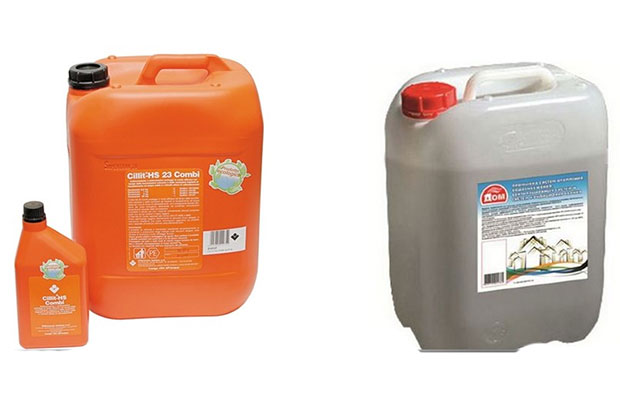
Used compounds do not destroy the inner surface of the pipes, from an ecological point of view they are completely safe. The technology is very simple and understandable. But, unfortunately, an ordinary person, far from sanitary wisdom, is not always able to correctly choose a preparation for cleaning system elements made of different materials. In most cases home master I am compelled to apply for consultations to specialists. Therefore, such a technique is used in everyday life relatively rarely.
A thorough flushing of the heating system is a long routine procedure that many homeowners tend to delay until the last minute. Meanwhile, the annual flushing of the heating system in a residential building, completed in the summer, will allow heating appliances to work at their peak efficiency and will save homeowners from the need to take emergency measures to clean the clogged radiators in the midst of winter cold.
 Many households and commercial buildings spend energy resources inexpediently and are forced to pay huge heating bills because the elements of the pipeline system are clogged. This phenomenon is observed everywhere, because regardless of the type of radiators and boilers used in the system, over time, there is the appearance of sludge and corrosion.
Many households and commercial buildings spend energy resources inexpediently and are forced to pay huge heating bills because the elements of the pipeline system are clogged. This phenomenon is observed everywhere, because regardless of the type of radiators and boilers used in the system, over time, there is the appearance of sludge and corrosion.
 If it was not made by the owners in accordance with the recommendations, serious blockages can appear inside the contour. They cause blocking of pipes, valves, boilers, pumps, heat exchangers, branch valves and can cause serious failures of heating equipment in the future.
If it was not made by the owners in accordance with the recommendations, serious blockages can appear inside the contour. They cause blocking of pipes, valves, boilers, pumps, heat exchangers, branch valves and can cause serious failures of heating equipment in the future.
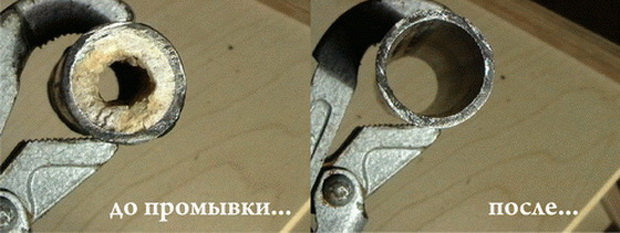 Avoid this phenomenon will help wash the heating system the price of which depends on the chosen method and the amount of work. It is necessary to regularly carry out a set of measures to maintain the effective operation of the heating system in order to avoid breakdowns and discomfort associated with uneven heating of radiators in the house.
Avoid this phenomenon will help wash the heating system the price of which depends on the chosen method and the amount of work. It is necessary to regularly carry out a set of measures to maintain the effective operation of the heating system in order to avoid breakdowns and discomfort associated with uneven heating of radiators in the house.
Methods of washing
 When the apartment house needs washing of heating systems, experts recommend using one of the three most effective methods. They are classified according to the equipment used in the washing process. By choosing the most the best option washing, the landlord will be able to forget about such problems as corrosion of radiators, the appearance of cold sections in the circuit and the breakdown of pumps and heat exchangers due to clogging.
When the apartment house needs washing of heating systems, experts recommend using one of the three most effective methods. They are classified according to the equipment used in the washing process. By choosing the most the best option washing, the landlord will be able to forget about such problems as corrosion of radiators, the appearance of cold sections in the circuit and the breakdown of pumps and heat exchangers due to clogging.
Chemical method
 For property owners, flushing chemical heating systems can be an acceptable tool in the fight for clean radiators. Before you wash the radiator in the apartment, it is important to read the instructions that govern the conduct of chemical flushing. Since toxic substances such as acids, solvents and alkalis can be included in the inhibitor, all work must be done extremely carefully and accurately.
For property owners, flushing chemical heating systems can be an acceptable tool in the fight for clean radiators. Before you wash the radiator in the apartment, it is important to read the instructions that govern the conduct of chemical flushing. Since toxic substances such as acids, solvents and alkalis can be included in the inhibitor, all work must be done extremely carefully and accurately.
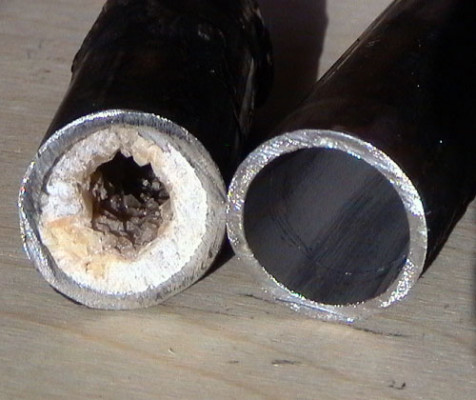 The principle of washing consists in that a chemical solution specially tailored for the specific type of radiators used in the system is poured into the circuit. To carry out work the owners of the house will need a simple set of tools - a large volume tank, hoses and electric pumps. After the solution is poured into the system, it is maintained for a certain time, after which the inhibitor is drained off. The spent chemical solution can not be poured into the soil without the addition of neutralizers, as this can damage the environment.
The principle of washing consists in that a chemical solution specially tailored for the specific type of radiators used in the system is poured into the circuit. To carry out work the owners of the house will need a simple set of tools - a large volume tank, hoses and electric pumps. After the solution is poured into the system, it is maintained for a certain time, after which the inhibitor is drained off. The spent chemical solution can not be poured into the soil without the addition of neutralizers, as this can damage the environment.
Properly flushed heating pipes using a chemical method allows you to achieve optimum efficiency and efficiency in the work of heaters.
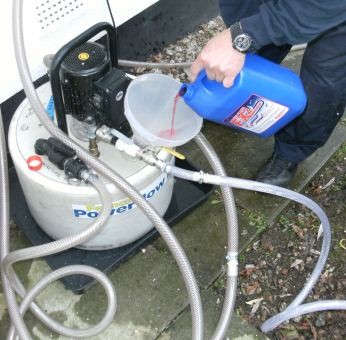 Systems that have not undergone regular chemical treatment can later be exposed to common problems such as noise in radiators, pump failure and the appearance of cold areas. Without chemical treatment, radiator systems will be subject to magnetite damage. This will provoke problems with the circulation of the coolant and reduce the efficiency of the heating devices, and in the future owners will be waiting for huge bills for utilities and poorly heated rooms in the house.
Systems that have not undergone regular chemical treatment can later be exposed to common problems such as noise in radiators, pump failure and the appearance of cold areas. Without chemical treatment, radiator systems will be subject to magnetite damage. This will provoke problems with the circulation of the coolant and reduce the efficiency of the heating devices, and in the future owners will be waiting for huge bills for utilities and poorly heated rooms in the house.
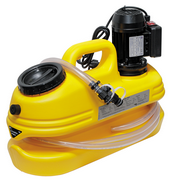 The above chemical washing method is quite effective, it allows you to remove a third of all contaminants in the system. However, you can find out how to clean the radiator more efficiently. To do this, it is necessary to clarify the possibility of experts renting professional pumping equipment, which in combination with a properly selected chemical solution will remove up to 80% of sludge and scale that accumulated over time on the internal walls of the radiators. This method allows you to remove the dirt in just a few hours, while it guarantees excellent results.
The above chemical washing method is quite effective, it allows you to remove a third of all contaminants in the system. However, you can find out how to clean the radiator more efficiently. To do this, it is necessary to clarify the possibility of experts renting professional pumping equipment, which in combination with a properly selected chemical solution will remove up to 80% of sludge and scale that accumulated over time on the internal walls of the radiators. This method allows you to remove the dirt in just a few hours, while it guarantees excellent results.
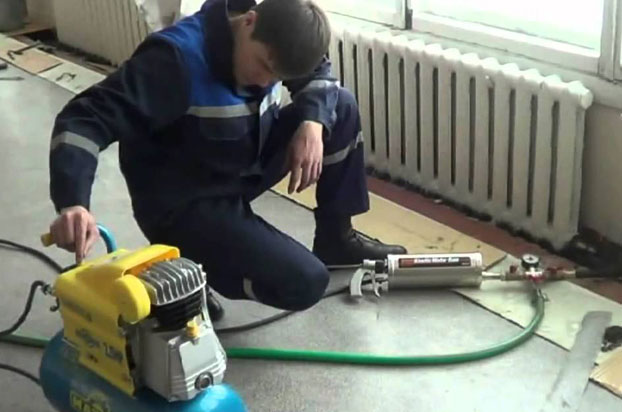 After the flushing of the heating system of a residential house the instruction of which is available on the network will be carried out, the clean radiators will begin to heat up much faster. It is important to remember that a pledge of competent chemical washing is a properly selected inhibitor. It is necessary to pay close attention to the choice of chemical reagents for washing, because with incorrect choice they can cause damage and cause the destruction of radiators and the appearance of leaks in the circuit.
After the flushing of the heating system of a residential house the instruction of which is available on the network will be carried out, the clean radiators will begin to heat up much faster. It is important to remember that a pledge of competent chemical washing is a properly selected inhibitor. It is necessary to pay close attention to the choice of chemical reagents for washing, because with incorrect choice they can cause damage and cause the destruction of radiators and the appearance of leaks in the circuit.
Cleaning with a pneumatic compressor
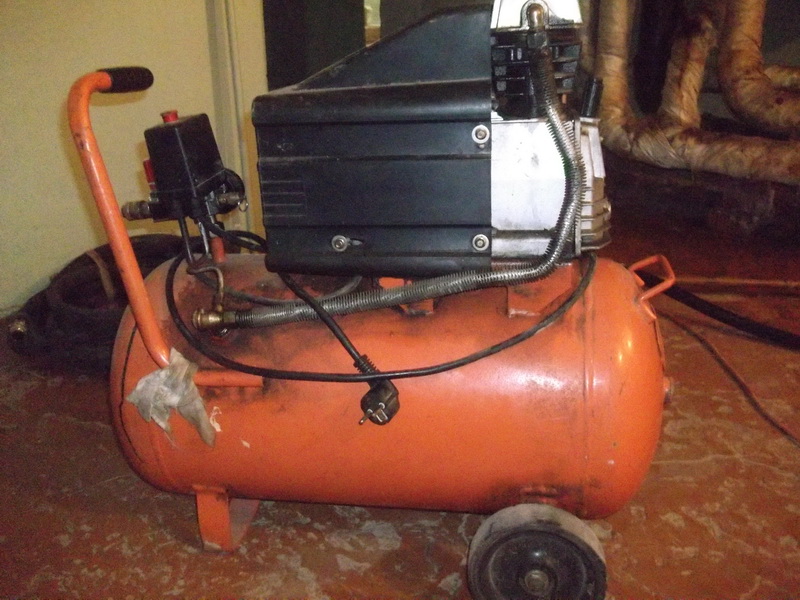 To maintain the purity of radiators and pipelines, a hydropneumatic flushing of the heating system can be used, the instruction of which regulates the order of actions and their sequence. To carry out the work, the owners will need a powerful pneumatic compressor, used to pressurize the water in the circuit. The principle of cleaning does not differ intricate and laborious.
To maintain the purity of radiators and pipelines, a hydropneumatic flushing of the heating system can be used, the instruction of which regulates the order of actions and their sequence. To carry out the work, the owners will need a powerful pneumatic compressor, used to pressurize the water in the circuit. The principle of cleaning does not differ intricate and laborious.
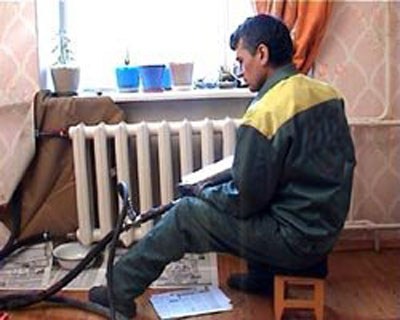 Before washing the owners it is necessary to connect the hose to the circuit, and to discharge the coolant into the sewer system under strong pressure. During emptying, the emulsified air / air mixture destroys the deposits on the walls of the radiators, and they are discharged to the outside. For better efficiency, the process should be repeated several times, alternately draining the water through the return path and vice versa.
Before washing the owners it is necessary to connect the hose to the circuit, and to discharge the coolant into the sewer system under strong pressure. During emptying, the emulsified air / air mixture destroys the deposits on the walls of the radiators, and they are discharged to the outside. For better efficiency, the process should be repeated several times, alternately draining the water through the return path and vice versa.
Passing under high pressure Through the entire contour, a powerful jet of water removes accumulations of debris and rust, solving the problem of cold spots and uneven heating of the radiators in height.
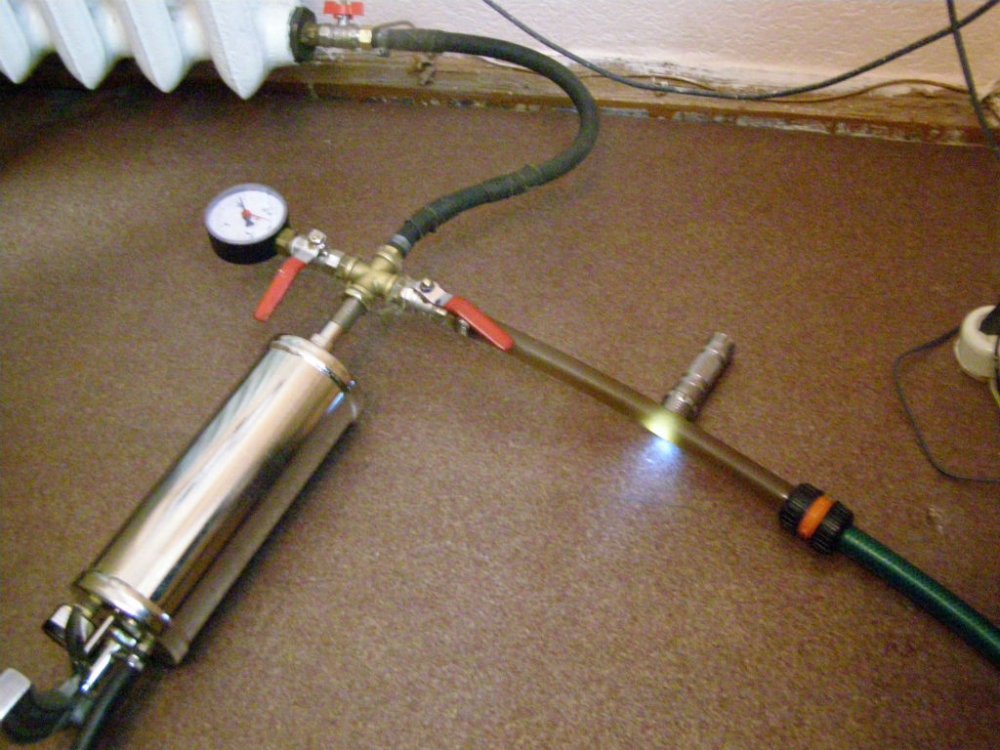 However, if the system has problems with only one radiator in the circuit, it is possible that the reason lies not in the clogging of the system by the slurry, but in the regulator malfunction or in the jamming of the thermostatic valve in the off position.
However, if the system has problems with only one radiator in the circuit, it is possible that the reason lies not in the clogging of the system by the slurry, but in the regulator malfunction or in the jamming of the thermostatic valve in the off position.
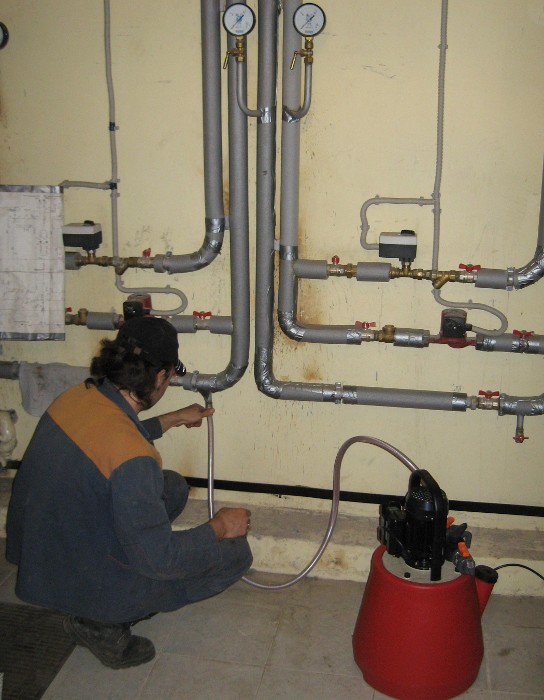 The most reliable indicator that a flushing of the entire system is required is the presence of problems with heating in many radiators connected to the circuit. If the problem of cold spots is typical for several radiators in the circuit, it means that a full hydropneumatic flushing of the heating system is inevitable.
The most reliable indicator that a flushing of the entire system is required is the presence of problems with heating in many radiators connected to the circuit. If the problem of cold spots is typical for several radiators in the circuit, it means that a full hydropneumatic flushing of the heating system is inevitable.
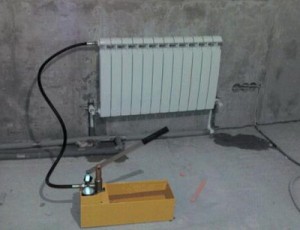 In some cases, a compressor for washing the heating system of an apartment building can work more efficiently. In particular, the operation of the pneumatic pump can be optimized by the use of additional abrasive powders added to the water. This method is used for cleaning seriously blocked heating systems that require powerful washing. To use the pneumatic compressor brought the expected effect, it is important for the owners to follow the order of work and follow the scheme of shutting down the return flow and discharge valves.
In some cases, a compressor for washing the heating system of an apartment building can work more efficiently. In particular, the operation of the pneumatic pump can be optimized by the use of additional abrasive powders added to the water. This method is used for cleaning seriously blocked heating systems that require powerful washing. To use the pneumatic compressor brought the expected effect, it is important for the owners to follow the order of work and follow the scheme of shutting down the return flow and discharge valves.
Pneumohydroimpulse cleaning
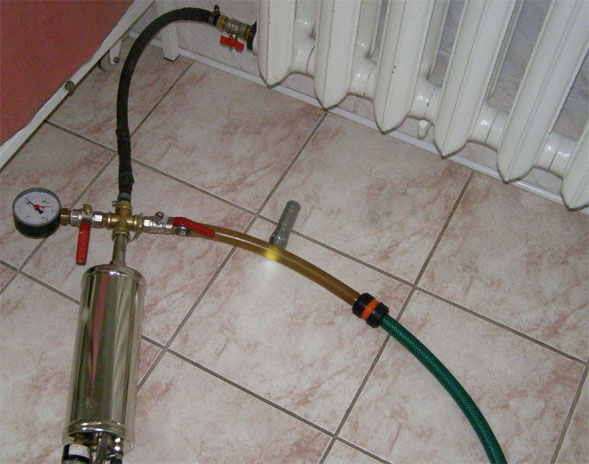 According to the OKPD, flushing of the heating system can be carried out using the pneumohydropulse method. Before cleaning the heating battery, it is necessary to prepare a number of tools. In particular, the main tool for conducting preventive works in the heating system will be a pneumatic gun. The peculiarity of the construction of this instrument makes it possible to carry out efficient work on cleaning radiators whose inner section diameter does not exceed one and a half centimeters.
According to the OKPD, flushing of the heating system can be carried out using the pneumohydropulse method. Before cleaning the heating battery, it is necessary to prepare a number of tools. In particular, the main tool for conducting preventive works in the heating system will be a pneumatic gun. The peculiarity of the construction of this instrument makes it possible to carry out efficient work on cleaning radiators whose inner section diameter does not exceed one and a half centimeters.
 Therefore, if the homeowner's plans have an item like cleaning a gas boiler with his own hands, he can not do without a quality pneumatic gun. The device can also be used to clean individual units and parts of the heating system. In particular, for washing coils, valves and other constructively complex contour elements.
Therefore, if the homeowner's plans have an item like cleaning a gas boiler with his own hands, he can not do without a quality pneumatic gun. The device can also be used to clean individual units and parts of the heating system. In particular, for washing coils, valves and other constructively complex contour elements.
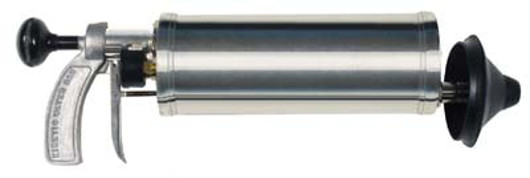 Working with a pneumatic gun is quite effective and washing the radiators with the help of it will take a specialist only a few hours. The principle of the pneumatic device is that it delivers high-speed pulses into the tube, the power of which is sufficient to destroy the deposit and deposits on the internal walls of the elements. During the procedure, the kinetic wave passes through the water, removes all contamination and removes them from the tube.
Working with a pneumatic gun is quite effective and washing the radiators with the help of it will take a specialist only a few hours. The principle of the pneumatic device is that it delivers high-speed pulses into the tube, the power of which is sufficient to destroy the deposit and deposits on the internal walls of the elements. During the procedure, the kinetic wave passes through the water, removes all contamination and removes them from the tube.
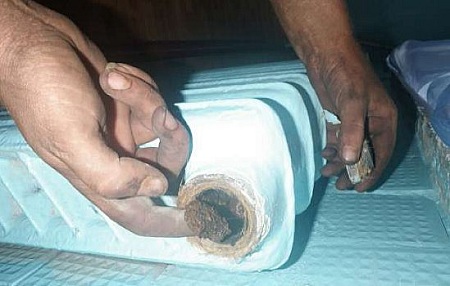 It is important to understand that the washing of the heating batteries, the price of which is discussed on an individual basis, should be carried out by professionals. Experts who have the skills to work with a pneumatic gun will be necessary calculations and will conduct the procedure in the most sparing mode. If this device is used by a person without experience and skills, it can cause destruction of the design and internal integrity of the heating appliances.
It is important to understand that the washing of the heating batteries, the price of which is discussed on an individual basis, should be carried out by professionals. Experts who have the skills to work with a pneumatic gun will be necessary calculations and will conduct the procedure in the most sparing mode. If this device is used by a person without experience and skills, it can cause destruction of the design and internal integrity of the heating appliances.
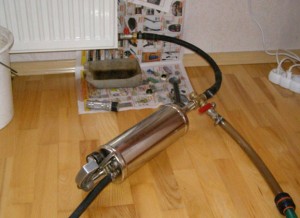 The correct washing of the heating system, whose price is fully justified by the economic effect in the form of full functioning of radiators and reduction of utility bills, is only appropriate if the owner has selected the correct method for cleaning the elements of the system. It is important to use an individual approach when considering options, given the type of radiators connected to the circuit, the format of the heating system, the internal design of the boiler and the degree of contamination of the elements.
The correct washing of the heating system, whose price is fully justified by the economic effect in the form of full functioning of radiators and reduction of utility bills, is only appropriate if the owner has selected the correct method for cleaning the elements of the system. It is important to use an individual approach when considering options, given the type of radiators connected to the circuit, the format of the heating system, the internal design of the boiler and the degree of contamination of the elements.
 After the system has been flushed, all contaminants - solder, slag, dust, scales and other foreign objects - are removed from the radiators and pipelines. The absence of debris inside the system will prevent the occurrence of corrosion, scaling or scale deposition occurring in the system over time, and will contribute to increasing the productivity and efficiency of all devices connected to the circuit.
After the system has been flushed, all contaminants - solder, slag, dust, scales and other foreign objects - are removed from the radiators and pipelines. The absence of debris inside the system will prevent the occurrence of corrosion, scaling or scale deposition occurring in the system over time, and will contribute to increasing the productivity and efficiency of all devices connected to the circuit.
Often there are situations where after several months of successful operation the heating system becomes less efficient. Specialists say that the efficiency of the heating network by the end of the season may decrease by 10%. Naturally, it is necessary to deal with the problem. But what causes it? In most cases, the cause of the deterioration of heating is the contamination of the heating system, which is eliminated only by washing.
Do I need to clean the heating system?
Hot water circulating through pipes is rarely of high quality, containing an impressive amount of various impurities. Reacting with the metal, the coolant causes the appearance of rust, but often the pipes are clogged with sediment from various organic compounds. It is the appearance of plaque that causes a decrease in the efficiency of heat release, which makes the washing of the system an obligatory stage of competent exploitation.
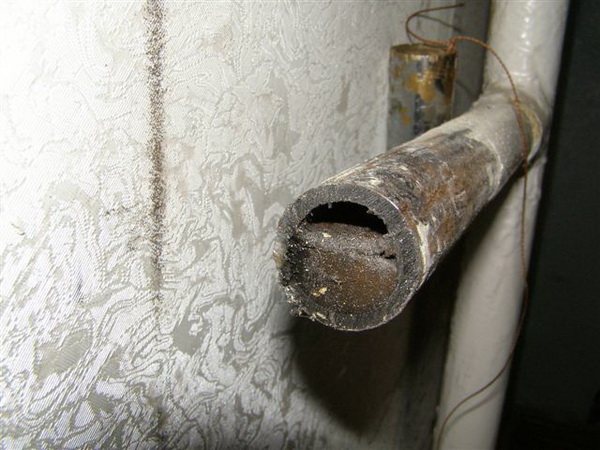
The horizontal sections of the heat network suffer the most from siltation, where the coolant passes slowly enough. With the problem of the appearance of silt is often encountered in the presence of cast-iron batteries, which differ in the impressive size of the sections. If the inner part of the pipe is made of steel without anti-corrosion coating, then another problem arises - mineral deposits. However, periodic heating requires heating networks from any metal.
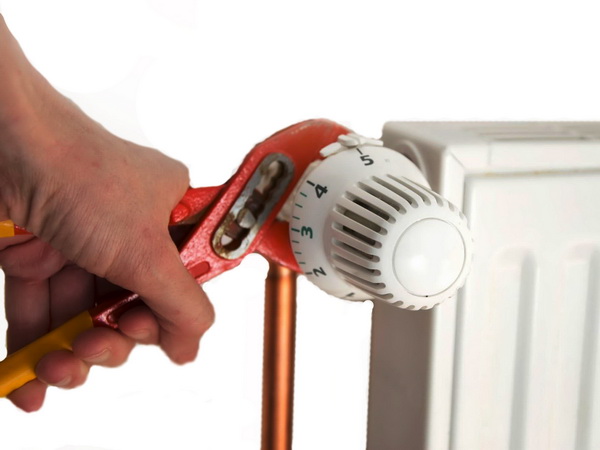
How can I clean the heating system of a private house?
Heating systems in private houses are contaminated with microparticles, which remain in the boiler, pipes and radiators after passing the coolant. Gradually accumulating, debris clogs the elements of the heating system, disrupting the water circulation. If you do not take action, heating the dwelling will become much less effective. There are several ways to flush the heating network, which will help eliminate various types of pollution and sediment.
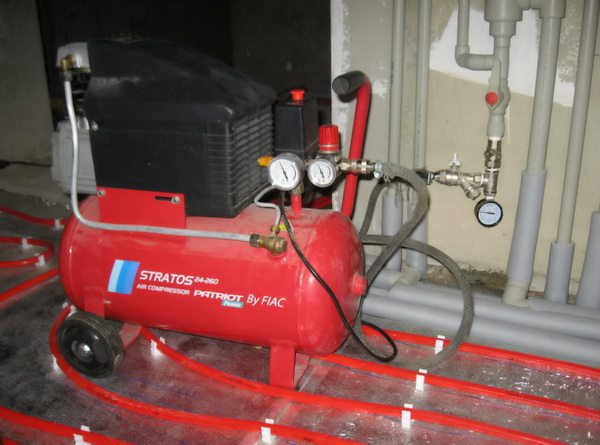
How to flush the heating system in a private house with pneumatic shock?
This cleaning option is suitable for homes with fairly old heating systems that use cast-iron radiators. The method is effective and practical, but requires the use of special equipment. Using hydropneumatic devices, masters create short, but strong enough waves, which remove contaminants from the walls of pipes and radiators.
This method is not dangerous for the system itself, since the impact is on the water flow. If the length of the heating network does not exceed 55-60 meters, then hydropneumatic flushing will be the optimal solution with a pipe diameter of 4 inches. The process itself is carried out in the shortest possible time - maximum after 50 minutes the system will be completely cleaned and ready for further operation.
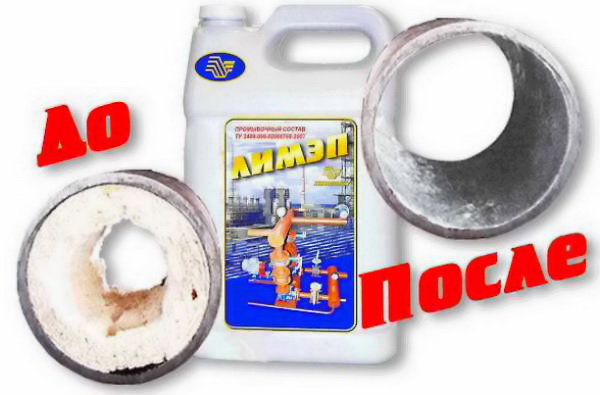
How to properly wash the house heating system with chemicals?
If the heating network is characterized by a rather complicated design, the problem arises with the removal of contaminants from hard-to-reach areas. In this case, experts recommend using special chemicals that will help quickly and permanently get rid of various deposits.
Such washing is carried out with the help of acids capable of quickly dealing with pollution. But this method can be dangerous for the heating system itself, because the active substances react with the metal, sometimes leading to damage to the walls of the pipes. Before using chemical cleaning it is desirable to objectively evaluate the condition of the heating system and analyze the available deposits.

How to flush the individual heating system with a water-pulsating mixture?
This type of cleaning also requires the use of special equipment, through which the heating network is filled with a combination of compressed air and water. The resulting pulsation promotes the rapid removal of various contaminants. This method makes it possible to quickly and effectively clean the pipes of rust, plaque and sediment. The efficiency of the heating system increases, as does its service life, and fuel and electricity consumption decreases.
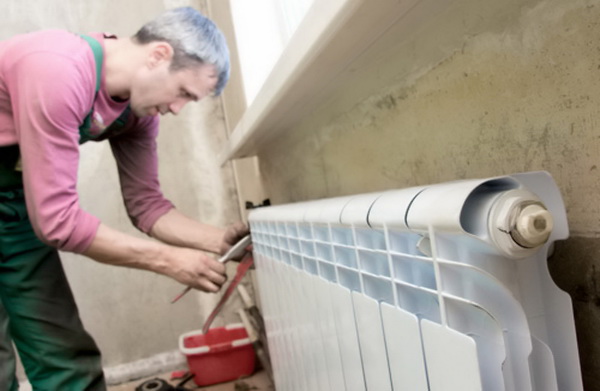
How to wash the heating system?
Specialists do not recommend to start cleaning the heating system on their own, as this could negatively affect the state of the entire system. And the quality of washing without the use of special tools and equipment will not be too high. However, if there are no other options, you can try to improve the heat transfer and on your own.
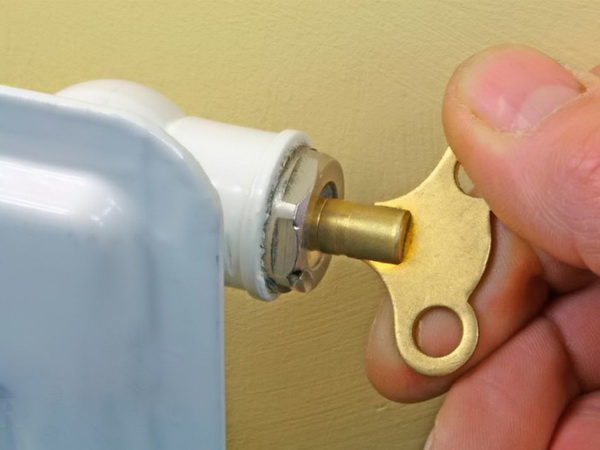
To flush the primary circuit, proceed as follows:
- Open the water valve, feeding the firebox.
- Open the valve supplying the reserve tank.
- Open the control and circulation jumper.
- Open the valve that lets the coolant pass to the batteries.
- Open the control valve.
- Open the return valve.
Then the last valve is closed, so that the coolant can pass through the drain pipe. When the cleaning is completed and all the valves are closed, you can start working with the remaining circuits.
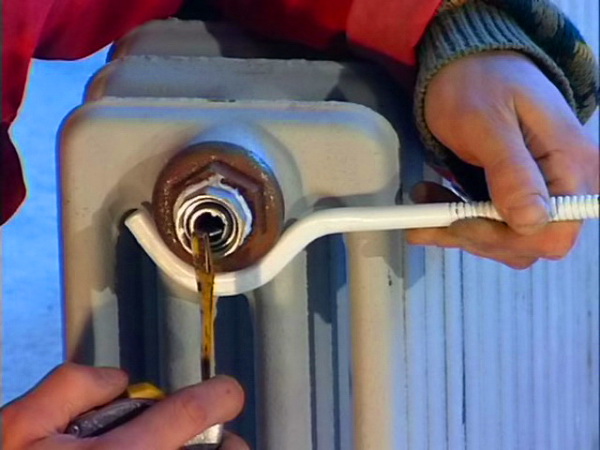
What kind of water is the heating system washed?
At the first stage, it is necessary to clean the system using cold water, which will remove various solids. To do this, all the cranes should be placed in the maximum open position for 2 hours. Then the water heated in the boiler, which dissolves the oil and partially cures the rust, comes into play. To increase the efficiency of work with hot washing, you can add a little bleach, enhancing the cleaning properties of water. This processing should be done not only during the operation of the system, but also immediately after its installation.
Water flushing on its own should preferably be done once a year. It is not recommended to drain the coolant out of the system for the period of inactivity, since the existing contaminants will harden and they can be removed only with the help of professional cleaning.

